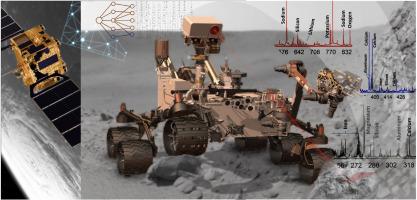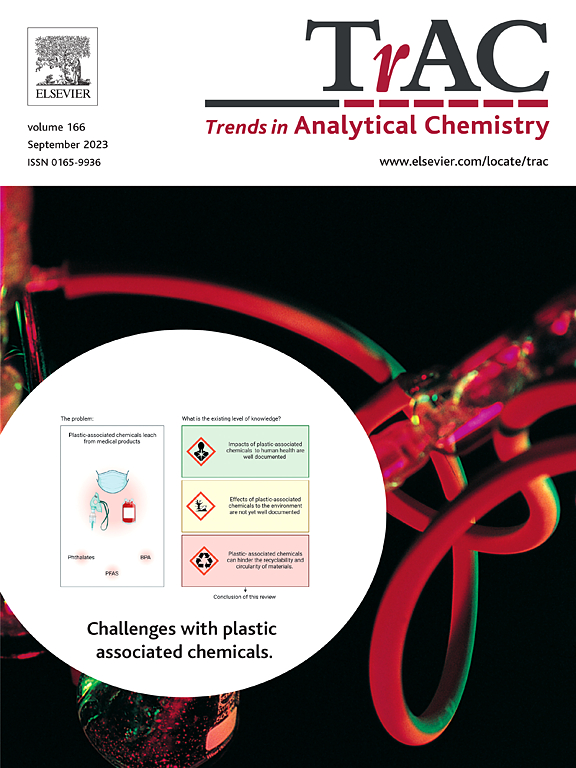空间应用中的激光诱导击穿光谱:回顾与展望
IF 11.8
1区 化学
Q1 CHEMISTRY, ANALYTICAL
引用次数: 0
摘要
这篇综述描述了基于光学发射光谱(OES)的分析方法在空间应用中的原理并总结了所面临的挑战,尤其侧重于激光诱导击穿光谱(LIBS)。在过去十年中,激光诱导击穿光谱已成为空间探索和天体原位资源利用(ISRU)的一种强大分析技术。有人建议在空间资源价值链的各个环节(包括勘探、采矿和选矿)采用这种技术。目前的火星任务,包括 "好奇号 "漫游车上的 ChemCam 仪器、"毅力号 "漫游车上的 SuperCam 仪器和 "祝融号 "漫游车上的 MarSCoDe 仪器,都被视为 LIBS 的旗舰应用。尽管 "Pragyan "漫游车和 "Vikram "着陆器都没有从月夜中醒来,但 "Chandrayaan-3 "任务的成功标志着LIBS仪器开发的又一个里程碑,预计还会有更多的任务,包括商业任务。此外,本文还强调了针对空间应用的数据处理的重要性,并强调了迁移学习的最新趋势。此外,LIBS 与其他光谱技术(如拉曼光谱、质谱和傅立叶变换红外光谱)相结合,是一个具有综合分析能力的令人感兴趣的平台。综述最后强调了基于 LIBS 技术的贡献在促进我们对天体的了解和为未来的太空探索努力铺平道路方面的重要意义。本文章由计算机程序翻译,如有差异,请以英文原文为准。

Laser-induced breakdown spectroscopy in space applications: Review and prospects
This review describes the principles and summarizes the challenges of analytical methods based on optical emission spectroscopy (OES) in space applications, with a particular focus on Laser-Induced Breakdown Spectroscopy (LIBS). Over the past decade, LIBS has emerged as a powerful analytical technique for space exploration and In-Situ Resource Utilization (ISRU) of celestial bodies. Its implementation has been suggested for various segments of the Space Resources Value Chain, including prospecting, mining, and beneficiation. Current missions to Mars, including the ChemCam instrument on the Curiosity rover, the SuperCam on the Perseverance rover, and the MarSCoDe on the Zhurong rover, are considered flagship applications of LIBS. Despite neither the Pragyan rover nor the Vikram lander waking from the lunar night, the success of the Chandrayaan-3 mission marks another milestone in the development of LIBS instruments, with further missions, including commercial ones, anticipated.
This paper reviews the deployment of LIBS payloads on Mars rovers, upcoming missions prospecting the Moon and asteroids, and LIBS analysis of meteorites. Additionally, it highlights the importance of data processing specific to space applications, emphasizing recent trends in transfer learning. Furthermore, LIBS combined with other spectroscopic techniques (e.g., Raman Spectroscopy, Mass Spectrometry, and Fourier-Transform Infrared Spectroscopy) represents an intriguing platform with comprehensive analytical capabilities. The review concludes by emphasizing the significance of LIBS-based contributions in advancing our understanding of celestial bodies and paving the way for future space exploration endeavors.
求助全文
通过发布文献求助,成功后即可免费获取论文全文。
去求助
来源期刊

Trends in Analytical Chemistry
化学-分析化学
CiteScore
20.00
自引率
4.60%
发文量
257
审稿时长
3.4 months
期刊介绍:
TrAC publishes succinct and critical overviews of recent advancements in analytical chemistry, designed to assist analytical chemists and other users of analytical techniques. These reviews offer excellent, up-to-date, and timely coverage of various topics within analytical chemistry. Encompassing areas such as analytical instrumentation, biomedical analysis, biomolecular analysis, biosensors, chemical analysis, chemometrics, clinical chemistry, drug discovery, environmental analysis and monitoring, food analysis, forensic science, laboratory automation, materials science, metabolomics, pesticide-residue analysis, pharmaceutical analysis, proteomics, surface science, and water analysis and monitoring, these critical reviews provide comprehensive insights for practitioners in the field.
 求助内容:
求助内容: 应助结果提醒方式:
应助结果提醒方式:


